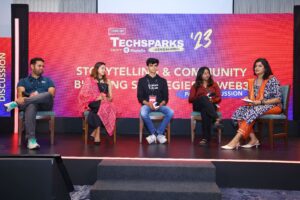I have been lucky that I had an opportunity to play an active role as a volunteer and office-bearer at NASSCOM, a not-for-profit, peer-to-peer organisation. Over the last 35 years, I’ve closely seen the maverick effect in action and observed how the association took shape, a step at a time.
I can draw numerous parallels between the co-founders of NASSCOM and the entrepreneurs of today. And I see a few differences as well. I can find this distinction and talk about this with some degree of confidence as I also have the vantage point of being an active angel investor. I get to see hundreds of pitch-decks and while I invest in just a handful, the quality of ideas in all those are world-class.
The younger lot today seems to have figured out the maverick mindset in their own way. I am reasonably confident that what the mavericks did back in the day with NASSCOM, the younger generation would do in a far grander and faster manner.
So when I was tasked with writing a set of lessons for my younger colleagues, I was left scratching my head. I rather decided to talk about what I believe we did right back in the day. I hope these serve as lessons and inspiration for the young entrepreneurs as they step on the pedal.
1. Build a culture of trust – not just within the industry, but also with all stakeholders
When we started NASSCOM, we were clear that we had to build a culture of trust – within the founders, early members, policymakers, regulators, various departments of government, ministers and more.
We realized we could do this if we allowed easy access and opened our internal meetings and conversations to everyone. We thus mandated that anyone from any government department could attend any of our meetings uninvited. More so, they could use our facilities as if it were their own. We wanted them to feel like one of us.
Further, we built trust by performance. As an industry, we continued to grow faster than anyone had imagined. Once the stakeholders saw us beating their estimates, like a part of the team, they encouraged us to do even more. Apart from this, when we were asked for some policy changes, we would work harder than anyone else and send back a detailed analysis that left literally no room for ambiguity. We eventually grew mutual trust to an extent that, at times, the typos we made in our recommendations would also appear in the final policy.
2. Collaborate and compete while keeping India first
I have seen numerous industries not reach their potential because the participants often act with a crab mentality. Rather than focusing on delivering their best, each participant works harder to bring the others down. While this sounds like a great short-term strategy, in the long term, the entire ecosystem suffers.
Instead, if we realize the merit and importance of growing the size of the pie, each participant could get access to a large slice. There is indeed merit in collaborating and competing. At NASSCOM, we worked hard to build a sizable business for India as a country and then encouraged fair and free-market principles between the players to capture their respective market shares. So the very companies that were fierce competitors in the market would come together as one when it came to speaking from a NASSCOM stage, representing India at global forums.
The way we at NASSCOM handled the Satyam incident, it was a clear case of how competing companies came together to salvage the brand India Inc, the careers of lakhs of Satyam employees, and eventually the business itself.
3. Focus on building an ecosystem
I define the ecosystem as the stakeholders that may not seem obvious at first glance. Allow me to give an example.
At NASSCOM, we could see very early on how Java would become a dominant programming language. We thus proactively worked with educational institutions to create a training program in Java. This allowed us to have a steady availability of talent when requests from clients started to come in. Similarly, we could spot how call centers would give birth to the BPM industry and we could start preparing for the incoming wave.
Today, the newer, emerging disciplines of deeptech and others will need us to invest in creating capability at the fundamental level. We need to up our game with both the fundamental R&D and applied R&D. This means we need to upgrade the course material, identify faculty, create training opportunities and then eventually, deliver when the application demands it. We need to encourage hunger at the grassroots level which eventually would translate into growing the ecosystem.
4. Proactive, consultative policymaking
Back in the day, the government departments did not know what software was. A section of media called it “softwear”. We had a hard time explaining the concept of an intangible getting beamed over the Internet.
Today, 35 years on, the awareness among people may be higher but there are still large gaping holes in the understanding of policymakers. How many public officers know what blockchain is? Metaverse? Genome Sequencing? Other such emerging areas?
Hardly a handful.
No, I am not blaming them. It is not their job to be experts. Rather, it is the responsibility of the industry to work closely with policymakers and help them understand the nuances. Further, the second-order effects and case studies must be presented to them so that they can look at the long-term impact and create a policy support structure that keeps the common man at the core and creates a level-playing field for businesses of all sizes and scales.
5. Grow the acumen to filter signal and noise
We at NASSCOM could see the BPO industry taking birth. We could see the long-term positive impact that 100 percent ownership in back-office operations would do to the fortunes of India. While there was immense criticism of the call center business, we could filter out the noise to imagine how it would give birth to the entire BPM ecosystem.
Thanks to a close-knit team at NASSCOM, we could engage in discussions and could filter out noise from signals and create a flywheel for the country.
In the world of startups, while there is noise, there are hundreds of signals as well. At the basic level, how do you filter these? And then at the next level, which signal to choose? Which one could create more jobs in the country? Which will create a higher per capita income? Which would be beneficial for the country in the long run?
The challenge is not new. It has merely grown in scale and taken a new cloak. The participants however are also smarter than us. Just that they need to get together and filter out signals, place priorities, and act.
The story of Indian IT is one of the most remarkable business stories that unfolded in our lifetimes. I was lucky to have a ringside view of the same and I am grateful for the opportunities I got. It was the consistent, patient, and sustained hard work of numerous mavericks that got us so far. We are now entering uncharted territories and I believe the readers of this platform have the baton and the mandate to take us ahead.
I have no doubt that the stories waiting to be written, of the conquest of my younger colleagues, will make each Indian’s head fly high with pride.
For more insights, get your copy of The Maverick Effect : The Inside Story of India’s IT Revolution by Harish Mehta.



![Read more about the article [Funding alert] Flow Club raises pre-seed round from Antler India](https://blog.digitalsevaa.com/wp-content/uploads/2021/07/c3706fc8aa882dc65eefe8c6d6d80bf6dc392b8e6cfe32bbe565d4904f58fd4e-1625550884415-300x150.jpg)






